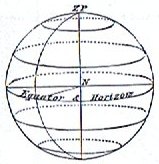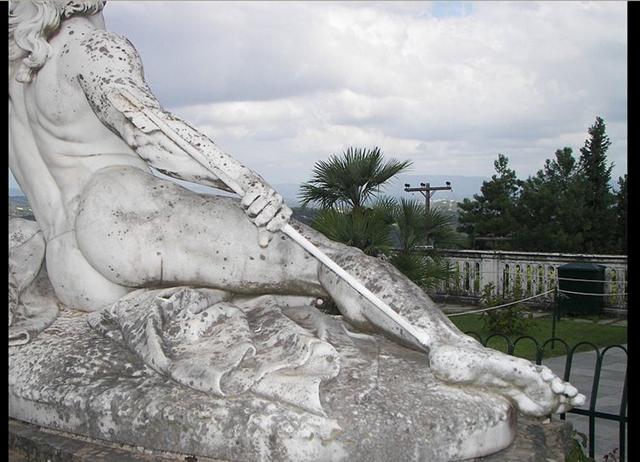There are 2 sides on a coin, a head and a tail. These names obviously refer to the beginning (*) respectively to the end (†). In the east the constellations were rising ('being born') - head first - and later, in due time and at the horizon in the west, they would 'go down' (with their tails as the last part in view). This is how 'life' works and this is how the night sky for an observer in the tropics would have seen it - fundamentally different from how people closer to the poles perceived the sky:   Therefore the Polynesians - who originally lived close to the equator - would have considered it as no difficulty at all to find as on a string Polaris, Baten Kaitos, and Metallah. Closely together and closely related. It would also have been natural to associate a birth with its opposite, indeed as causally related events, beautifully explained in the myth about 'the Breadfruit' (Ulu) and his little son 'Living Island' (Mokuola): ... When the man, Ulu, returned to his wife from his visit to the temple at Puueo, he said, 'I have heard the voice of the noble Mo'o, and he has told me that tonight, as soon as darkness draws over the sea and the fires of the volcano goddess, Pele, light the clouds over the crater of Mount Kilauea, the black cloth will cover my head. And when the breath has gone from my body and my spirit has departed to the realms of the dead, you are to bury my head carefully near our spring of running water. Plant my heart and entrails near the door of the house. My feet, legs, and arms, hide in the same manner. Then lie down upon the couch where the two of us have reposed so often, listen carefully throughout the night, and do not go forth before the sun has reddened the morning sky. If, in the silence of the night, you should hear noises as of falling leaves and flowers, and afterward as of heavy fruit dropping to the ground, you will know that my prayer has been granted: the life of our little boy will be saved.' And having said that, Ulu fell on his face and died. His wife sang a dirge of lament, but did precisely as she was told, and in the morning she found her house surrounded by a perfect thicket of vegetation. 'Before the door,' we are told in Thomas Thrum's rendition of the legend, 'on the very spot where she had buried her husband's heart, there grew a stately tree covered over with broad, green leaves dripping with dew and shining in the early sunlight, while on the grass lay the ripe, round fruit, where it had fallen from the branches above. And this tree she called Ulu (breadfruit) in honor of her husband. The little spring was concealed by a succulent growth of strange plants, bearing gigantic leaves and pendant clusters of long yellow fruit, which she named bananas. The intervening space was filled with a luxuriant growth of slender stems and twining vines, of which she called the former sugar-cane and the latter yams; while all around the house were growing little shrubs and esculent roots, to each one of which she gave an appropriate name. Then summoning her little boy, she bade him gather the breadfruit and bananas, and, reserving the largest and best for the gods, roasted the remainder in the hot coals, telling him that in the future this should be his food. With the first mouthful, health returned to the body of the child, and from that time he grew in strength and stature until he attained to the fulness of perfect manhood. He became a mighty warrior in those days, and was known throughout all the island, so that when he died, his name, Mokuola, was given to the islet in the bay of Hilo where his bones were buried; by which name it is called even to the present time. At the beginning of side a of the tablet I perceived the young newly born year and at the beginning of side b the final of 'the Old Man' (at the other side of the horizon in the west). They were closely connected, yet on different sides of the tablet. Side a seemed to begin 'out on the reef' where the baby boy was beeing born - washed up like young Maui - and inhaled his first breath. After his father had 'ex-spired'out at Sea: ... There is a couple residing in one place named Kui and Fakataka. After the couple stay together for a while Fakataka is pregnant. So they go away because they wish to go to another place - they go. The canoe goes and goes, the wind roars, the sea churns, the canoe sinks. Kui expires while Fakataka swims. Fakataka swims and swims, reaching another land. She goes there and stays on the upraised reef in the freshwater pools on the reef, and there delivers her child, a boy child. She gives him the name Taetagaloa. When the baby is born a golden plover flies over and alights upon the reef. (Kua fanau lā te pepe kae lele mai te tuli oi tū mai i te papa). And so the woman thus names various parts of the child beginning with the name 'the plover' (tuli): neck (tuliulu), elbow (tulilima), knee (tulivae) ... The human mammal has lost his tail and instead Andromeda had Alamak at her heel: ... Gamma Andromedae ... is the third brightest star in the constellation of Andromeda. It is also known by the traditional name Almach (also spelt as Almaach, Almaack, Almak, Almaak, or Alamak), from the Arabic العناق الأرض al-‘anāq al-’arđ ... 'the caracal' (desert lynx) ...
Cats have tails and the name Alamak could have been coined to explain the meaning of Andromeda's heel. Achilles was finished by an arrow shot at his only vulnerable spot, viz. his heel (which had not been dipped in Styx). "... Styx had miraculous powers and could make someone invulnerable. According to one tradition, Achilles was dipped in it in his childhood, acquiring invulnerability, with exception of his heel, by which his mother held him. This is the source of the expression Achilles' heel, a metaphor for a vulnerable spot." (Wikipedia) It was Nara, Old Age, who shot this arrow (I have read somewhere). Birth and death seldom occur together at the same time and the author of the C text may have found a way to keep them apart by beginning with the birth and then to extend the length of the text on side a so that the death (of the old world view) would come at the beginning of side b.
|

